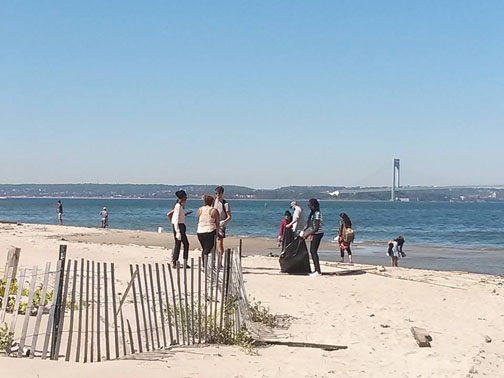
By Dominique M. Carson
Recently, educators, administrators, and organizations joined together at John Dewey High School's STEM collaborative meeting to discuss how to apply K-12 sustainability themes to the New York Waterfront.
STEM is an acronym for Science, Technology, Engineering, and Math education that gives students a better understanding as to why these subjects intertwine with the real world and how it's imperative for students' success.
At the meeting, Lane Rosen, John Dewey High School's Marine Biology Teacher and assistant principal explained why it's necessary for schools and various agencies to collaborate with each other, create a STEM Pathway from kindergarten to college, and provide leadership roles for students from the STEM collaborative program.
"STEM has always been a part of Dewey; I started at Dewey around 2002 and we already started doing some wonderful things in the program. My colleague, Mr. White, from Edward R. Murrow High School and I did a sand dune restoration with about 30 students and a grant from the New York Aquarium. The kids really got involved in all of the field studies," said Rosen. "We did fishing, looked at different animals and measured them, we kayaked, the kids participated in field studies and it was great."
Rosen also mentioned Dewey's robotics lab that allows students to construct robots after school and they compete annually in the FIRST Robotics Competition (FRC). The school has an aquarium classroom that teaches pupils how to take care of the aquarium and the fish.
Linda Curtis-Bey, Executive Director, STEM, NYCDOE also shared a few words about the program and why the Department of Education should work on engaging students about what they need to know about STEM. She says teachers need to build a framework for students to figure out the relevance in various STEM topics so they can understand the bigger picture once they leave the classroom.
"Having done this for a quite few years now and working with professional development of teachers, principals, and administrators, I began to understand the idea that once you start teaching, you really start understanding what you're teaching. "For me, STEM is about how we take what we know in the areas of science, technology, engineering, and mathematics and apply it. It's about problem solving and figuring out different ways to solve the problem. Through the process I think we get students to understand math, technology, and science but also engage in their communities and environments and what's around them."
US Navy Career Counselor Chief Freddie McAbee and Michael Fourte, Lt. Commander were present and shared how STEM helped them create a remotely operated vehicle for the SeaPerch Challenge. While the students are building the vehicle, they are learning about ship and submarine design, naval architecture, and the origins of the ocean and marine biology. The SeaPerch Challenge is an underwater robotics program that encourages teachers and students to learn more about engineering, technology, science, mathematics, and robotics.
The next assignment for the STEM collaborative team is to work on a marine educational workshop, "It's My Park Day," at the Kaiser Park Waterfront with Gene Ritter from Cultural Research Divers and City Parks Foundation.
The overview of the STEM collaborative meeting was a "natural outgrowth" for everyone to figure out how they get more students, schools, and organizations involved in their community and environmental based activities on the STEM curriculum.
Kathleen Elvin, Principal of John Dewey High School summed it up by saying: "We have lots of opportunities in this room for our kids to learn together, to learn from each other and to have those experiences that I think everybody remembers. The trips they had in elementary, middle, and high school, the projects they completed, that's where we build a science community. It becomes the culture; it becomes the way we do things instead of just the things we learn in the classroom." #

Leave a comment